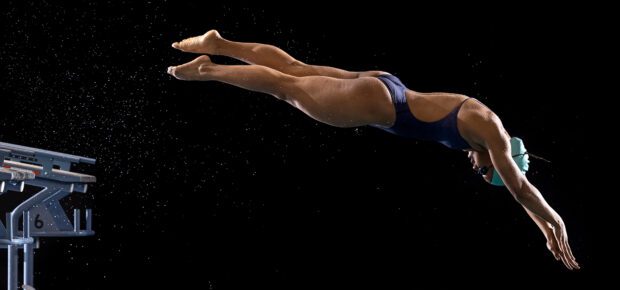July 16, 2024
At the Tokyo Olympic Games in 2021, athletes smashed through 20 world records. Athletics played a role in those achievements, but technology did too. Much of the credit was given to new shoe technology in running events. A new type of swimsuit was seen as giving some athletes a slight edge in swimming.
Technology has also been deeply embedded in the training regimen for elite athletes. For decades, coaches and trainers have leveraged tools like low-cost sensors, machine vision and big data analytics to improve nutrition, protect athletes from injury and analyze team strategy.
Today, artificial intelligence is bringing it all together, according to IEEE Fellow Karen Panetta.
“The role of video image processing to analyze an athlete’s performance has been available for quite some time,” Panetta said. “What is new is the role AI now plays in concert with the multitude of low-cost sensors that collect data on a specific individual’s movements. The data collected allows AI to look at every body part’s position throughout the execution of movement, including the forces and movement trajectories, and compare it to optimal performance. The feedback can help the athlete address specific areas of concern, especially stresses and strains that could cause injuries from improper form and execution.”
Here’s a look at some of the latest:
Deploying Chaos in Soccer:
In modern sports, especially in soccer, tactics play a crucial role in determining the outcome. Researchers relied on a statistical data set that described where certain events, like passes or shots on goal, happened on the field. They crunched a massive amount of data to show that randomness in team movements, like unpredictable passes, can give teams a competitive edge. The study developed new tools to identify randomness and unpredictability. The number crunching revealed that high randomness was especially beneficial early in the match to create scoring opportunities and confuse opponents. Toward the second half of a match, successful teams tended to switch to defensive play strategies.
Shooting Your Shot
Basketball shooting is a complex skill. AI is making it easier to master. By analyzing player skills and movement patterns, AI is introducing new training methods and performance improvement.
A recent article in IEEE Xplore summarizes the mountains of research into basketball shooting, which includes machine vision techniques and artificial intelligence to analyze players posture and the trajectory of the ball. Other programs are dedicated to helping players optimize their free throw form, showing them where they make mistakes and how to correct them.
Diving Right In
Analyzing athletes’ body poses and motions is a hot topic in sports tech, especially with AI in the mix. Sports like diving and gymnastics involve complex moves, making video analysis challenging due to issues like motion blur. While manual analysis, however, is slow and error-prone. AI might allow coaches and trainers to provide real-time, accurate feedback.
New Frontiers in Performance and Safety
For Panetta, the rise of AI may also lead to two new developments: increasing adoption of technology at non-elite levels and the ability to make sports safer.
“Professional sports teams were the first to use these technologies in the 1990s because they had the funds to pay for the expensive computational requirements, complex sensor configurations, and skilled human operators who could analyze the system’s output,” Panetta said.
“Today, the availability of cloud computing and low-cost sensor technologies have opened new pathways for all consumers to leverage the benefits of these technologies to keep us healthy or ensure we are not hurting ourselves.”
Learn more: As everyone looks toward the 2024 Paris Olympics, the IEEE Standards Association produced this video to show how standards have raised the bar on sustainable planning and execution of world-class events.






 The Impact of Technology in 2025
The Impact of Technology in 2025 Quantum and AI: Safeguards or Threats to Cybersecurity?
Quantum and AI: Safeguards or Threats to Cybersecurity? Why AI Can't Live Without Us
Why AI Can't Live Without Us Bits, Bytes, Buildings and Bridges: Digital-Driven Infrastructure
Bits, Bytes, Buildings and Bridges: Digital-Driven Infrastructure Impact of Technology in 2024
Impact of Technology in 2024 Emerging AI Cybersecurity Challenges and Solutions
Emerging AI Cybersecurity Challenges and Solutions The Skies are Unlimited
The Skies are Unlimited Smart Cities 2030: How Tech is Reshaping Urbanscapes
Smart Cities 2030: How Tech is Reshaping Urbanscapes Impact of Technology 2023
Impact of Technology 2023 Cybersecurity for Life-Changing Innovations
Cybersecurity for Life-Changing Innovations Smarter Wearables Healthier Life
Smarter Wearables Healthier Life Infrastructure In Motion
Infrastructure In Motion The Impact of Tech in 2022 and Beyond
The Impact of Tech in 2022 and Beyond Cybersecurity, Technology and Protecting Our World
Cybersecurity, Technology and Protecting Our World How Technology Helps us Understand Our Health and Wellness
How Technology Helps us Understand Our Health and Wellness The Resilience of Humanity
The Resilience of Humanity Harnessing and Sustaining our Natural Resources
Harnessing and Sustaining our Natural Resources Creating Healthy Spaces Through Technology
Creating Healthy Spaces Through Technology Exceptional Infrastructure Challenges, Technology and Humanity
Exceptional Infrastructure Challenges, Technology and Humanity The Global Impact of IEEE's 802 Standards
The Global Impact of IEEE's 802 Standards Scenes of our Cyber Lives: The Security Threats and Technology Solutions Protecting Us
Scenes of our Cyber Lives: The Security Threats and Technology Solutions Protecting Us How Millennial Parents are Embracing Health and Wellness Technologies for Their Generation Alpha Kids
How Millennial Parents are Embracing Health and Wellness Technologies for Their Generation Alpha Kids Space Exploration, Technology and Our Lives
Space Exploration, Technology and Our Lives Global Innovation and the Environment
Global Innovation and the Environment How Technology, Privacy and Security are Changing Each Other (And Us)
How Technology, Privacy and Security are Changing Each Other (And Us) Find us in booth 31506, LVCC South Hall 3 and experience the Technology Moon Walk
Find us in booth 31506, LVCC South Hall 3 and experience the Technology Moon Walk Virtual and Mixed Reality
Virtual and Mixed Reality How Robots are Improving our Health
How Robots are Improving our Health IEEE Experts and the Robots They are Teaching
IEEE Experts and the Robots They are Teaching See how millennial parents around the world see AI impacting the lives of their tech-infused offspring
See how millennial parents around the world see AI impacting the lives of their tech-infused offspring Take the journey from farm to table and learn how IoT will help us reach the rising demand for food production
Take the journey from farm to table and learn how IoT will help us reach the rising demand for food production Watch technical experts discuss the latest cyber threats
Watch technical experts discuss the latest cyber threats Explore how researchers, teachers, explorers, healthcare and medical professionals use immersive technologies
Explore how researchers, teachers, explorers, healthcare and medical professionals use immersive technologies Follow the timeline to see how Generation AI will be impacted by technology
Follow the timeline to see how Generation AI will be impacted by technology Learn how your IoT data can be used by experiencing a day in a connected life
Learn how your IoT data can be used by experiencing a day in a connected life Listen to technical experts discuss the biggest security threats today
Listen to technical experts discuss the biggest security threats today See how tech has influenced and evolved with the Games
See how tech has influenced and evolved with the Games Enter our virtual home to explore the IoT (Internet of Things) technologies
Enter our virtual home to explore the IoT (Internet of Things) technologies Explore an interactive map showcasing exciting innovations in robotics
Explore an interactive map showcasing exciting innovations in robotics Interactively explore A.I. in recent Hollywood movies
Interactively explore A.I. in recent Hollywood movies Get immersed in technologies that will improve patients' lives
Get immersed in technologies that will improve patients' lives